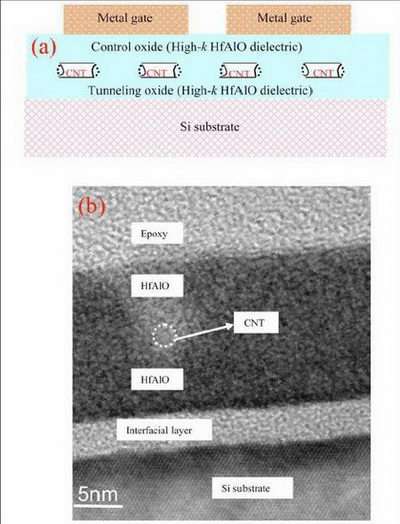April 3, 2006 feature
Carbon Nanotubes with a Memory

Carbon nanotubes have successfully been made into a variety of nanoscale circuit components, including transistors, inverters, and switches. Now, a pair of scientists has made a rough, yet promising, flash memory device out of carbon nanotubes. The device is a long way from a finished, marketable product, but it nonetheless represents a significant step in the drive to incorporate carbon nanotubes into mainstream electronics.
“Unlike similar devices that have been made, which use carbon nanotubes but can only operate at very low, very impractical temperatures, our device displays impressive long-term information retention characteristics at room temperature,” said lead researcher Jiyan Dai, a physicist at The Hong Kong Polytechnic University, to PhysOrg.com. “This indicates that mainstream carbon nanotube-based flash memory devices are a real possibility.”
Flash memory devices are currently used to store data in many types of electronic items, including digital cameras, USB memory sticks, and cell phones. Flash memory is considered a “non-volatile” form of memory, meaning it can retain data without a constant supply of power.
A typical flash memory device stores information within a grid of transistors called cells. Each cell consists of three layers: a “control gate” compound and a “floating gate” compound separated by a thin layer of an insulating oxide compound. When a voltage is applied to the cell, electrons build up as negative electric charge in the floating gate. At a certain threshold of charge, the floating gate is considered closed and the cell is thought to have a value of “0.” When the charge drops below that level, the gate is open and the cell has a value of “1.” In this way, each cell is able to hold one bit of information (there are eight bits in one byte).
Dai and co-researcher X.B. Lu created their flash memory device using carbon nanotubes as the charge-storage layer. As described in a paper in the online edition of Applied Physics Letters, they embedded the nanotubes in a compound made of the elements hafnium, aluminum, and oxygen, abbreviated HfAlO, which serves as both the control gate and the oxide layer. This carbon-nanotube “sandwich,” with each layer only several nanometers in thickness, sits on a substrate of silicon.
Dai and Lu determined the charge-retention characteristics of the device by measuring, first, its capacitance (how well it stores electric charge) as a function of the voltage applied across it. They also measured how well the device held onto its charge as time elapsed, from fractions of a second up to nearly three hours. They found that the short-term charge retention wasn’t excellent. During the first couple of minutes, the “memory window” — the voltage range over which the device can retain information — became narrower, a property that is not desirable for flash memory devices. However, over the long term, the memory window remained at a value of about 0.5 V.
“We believe that the excellent long-term charge-retention characteristics of our device are due to the unique structure and electrical properties of carbon nanotubes,” said Dai.
Citation: “Memory effects of carbon nanotubes as charge storage nodes for floating gate memory applications,” Applied Physics Letters 88, 113104 (2006)
By Laura Mgrdichian, Copyright 2006 PhysOrg.com















